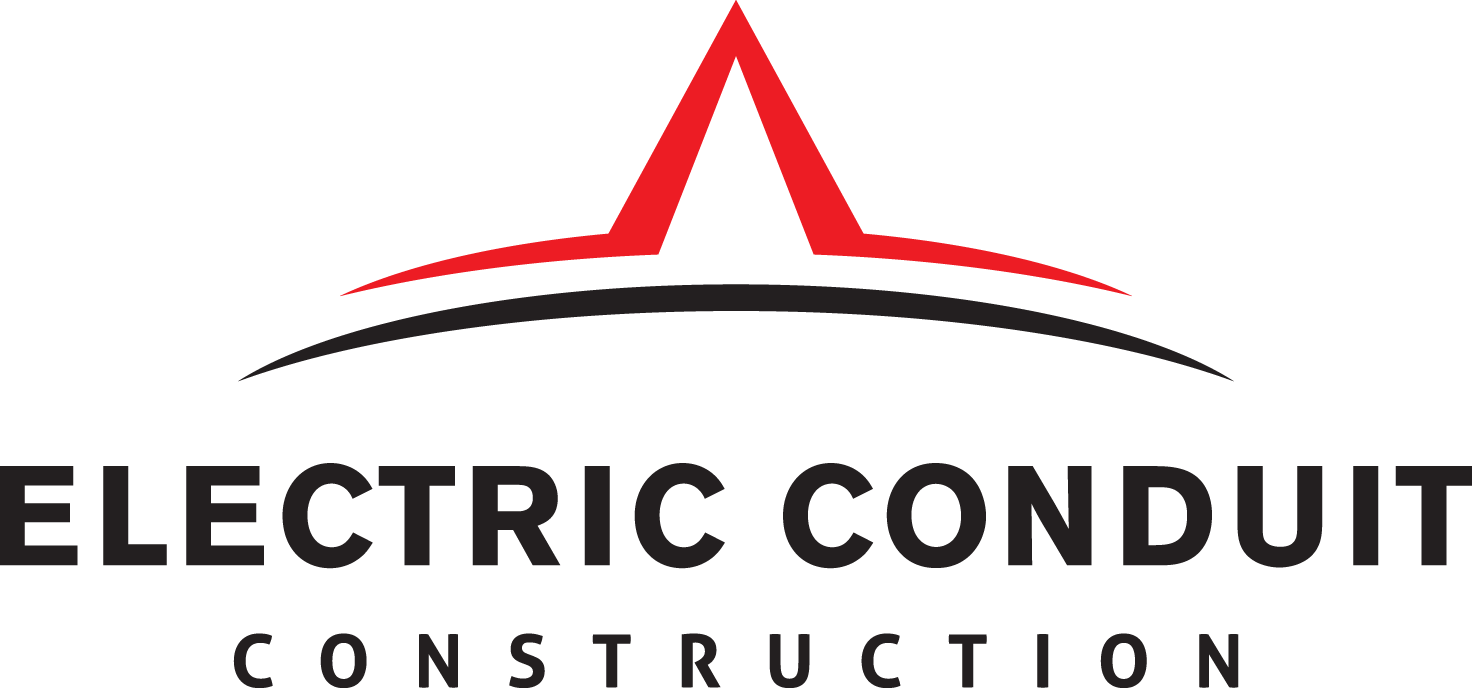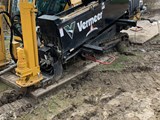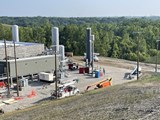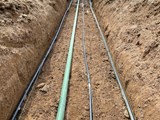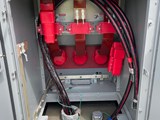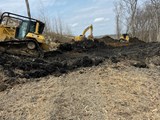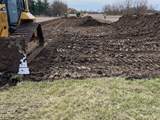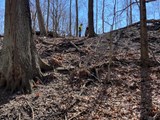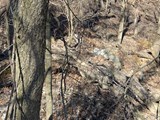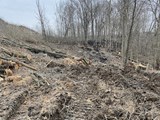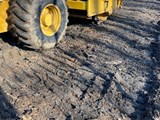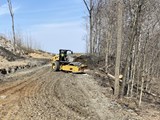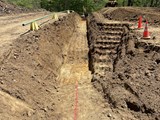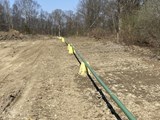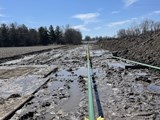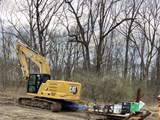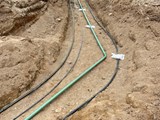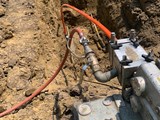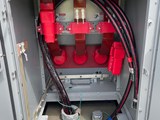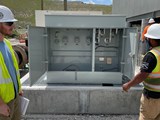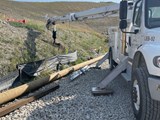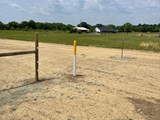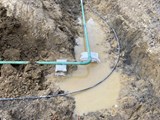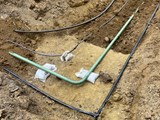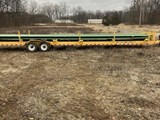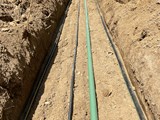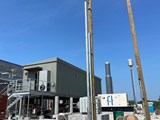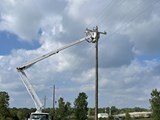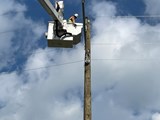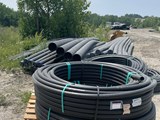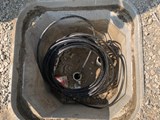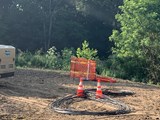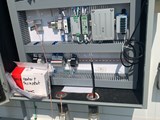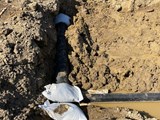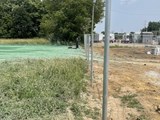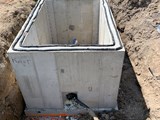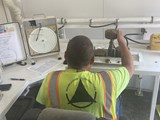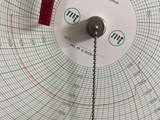Renewable Natural Gas Project
AMERESCO Renewable Natural Gas Project
AMERESCO
At Ameresco, we design, build, own, operate and maintain renewable energy plants that convert otherwise-wasted byproduct gas into useful forms of energy. These facilities process raw biogas generated from sources such as landfills and wastewater treatment facilities into a RNG product that can be injected into the natural gas pipeline network and transported anywhere in the United States. This “Green Gas” has been promoted under the Renewable Fuel Standard program.
ELECTRIC CONDUIT CONSTRUCTION & MIDWESTERN CONTRACTORS
In the fall of 2022 AMERESCO awarded Midwestern Contractors (MWC) and its parent company Electric Conduit Construction (ECC) a contract to build a renewable natural gas project to transport landfill gas to an interconnect point 10,000 feet from the source. During the fall and into 2023 MWC & ECC built this project. In addition to a RNG pipeline, the trench contained a fuel gas line, fiber optic cable and a water line to supply fuel, communications, and water to the gas processing plant. Later in the project ECC extended distribution power to the plant.
"Electrical safety, fall protection and rigging were uppermost in our minds as we extended distribution power to the plant."
Jeff Larson, Safety Coordinator
ROW clearing and preparation.
Most of the 10,000 foot right of way was agricultural land. Other than excess surface water from rainfall, this portion required straightforward excavation techniques. Topsoil was segregated and the trench excavation proceeded smoothly. Another 1,500 feet of the right of way passed through rolling forest land. This portion required riprap in the swales and extensive cutting, filling, and compaction to create a serviceable and accessible road and trench for the utilities.
Trees were cut, marketable timber hauled off and the rest of the wood was chipped or mulched. Two D-9 dozers and a compactor were utilized to grade, compact, and create a stable surface. The pipeline trench was excavated after completing compaction. After the grading the entire ROW was seeded with perennial grasses.
Trenching
Except for 1,500 feet, the entire pipeline was installed using open cut methods. Depth to top of pipe was 48 inches. The four-foot-wide trench allowed for the orderly spacing of the RNG gas pipeline, the fuel gas pipeline, the water pipeline, and the fiber optic communications line. The fiber optic cable was blown in after the conduit was laid and backfilled.
Horizontal directional drill
Horizontal directional drilling was used to install the RNG pipeline, and fiber optic communications cable. The initial drill followed the prescribed path to pull back the 3-inch steel RNG Pipe and 1.5-inch conduit for the fiber optic cable. The final ream size was 8-inches. Maximum depth of the drill was 20 feet.
Combined RNG, fuel gas, fiber, and water
The design called for a four-foot-wide ditch to accommodate the multiple utilities. Each utility was spaced one foot apart. Tracer wire was added to aid locating, should repair ever become necessary. In rocky areas sandbags and sand was used to pad the pipeline and the utilities.
Installation of utilities was straightforward. The RNG pipeline was made of 3-inch carbon steel. The pipe was joined by welding with every joint X-rayed. One hundred percent of the welds passed X-ray testing. All joints were coated with DENSO 7200 and tested for specified thickness. The 2-inch fuel gas line was HDPE gas pipe, and it was fused. The 2-inch water line was HDPE rated for potable water and fused. All HDPE pipe was pressure tested. The 3-inch steel pipe was hydrostatically tested. Conduit was laid for the fiber optic cable and connected to the drilled section. After all conduit was connected the fiber was blown through to each hand hole wear slack was stored for future use.
Extending power
To reach the gas processing plant distribution power was extended 2,700 feet. 16 poles were set, cross arms and hardware were installed, and wire strung to the transformers and switch gear bringing the power in at 480 volts, three phase.
Restoration
The portions of the ROW in tillage had the topsoil replaced and received a finish grade to bring the field surface back to the same grade. The balance of the ROW was seeded to perennial grasses.
Commissioning
RNG projects require a dedicated commissioning crew made up of technicians, manufacturers reps, and construction trades to properly test and start up the equipment in a sequential fashion. Installed systems are tested for leaks prior to placing into service.
Click on an image to expand and initiate a slide show
Safety notes
This RNG project required crews to perform repetitive tasks. Repetition can lead to complacency and this in turn can lead to accidents and injuries. Repetitive tasks like loading and unloading pipe, excavation and welding can focus the mind on the task and take away safety awareness. A key focus of the safety program for this project was to emphasize hazard awareness in the daily safety briefs. The foremen, and safety officers reinforced this during each day and through safety audits.
Specific safety issues included:
- Vehicle / equipment movement in the laydown yard and on the ROW
- Managing slips/strip/falls (ROW would get extremely muddy during rain events).
- Vetting subcontractors’ safety program and training
- Including subcontractors in MWC and ECC safety meetings and toolbox talks
- Ensuring our crews work safely around other subcontractors. (X-ray, HDD).
- Following procedures for loading and unloading pipe.
- Ensuring all employees on site stay protected from flying debris and UV light.
- Attention to documentation for coating, weld maps, MTR’s, redline drawings and other.
Safety training
- AMERESCO and Energy Transfer safety site specific trainings are conducted prior to anyone starting work on site. This includes topics related to high hazardous activities that each contractor might be involved with.
- Daily JSA (Job Safety Analysis) are conducted by each trade for each activity taking place and discussed with the crews. JSAs cover the safety concerns and possible results of the specific task being performed. Multiple JSAs might be done by the same contractor if working on multiple tasks at the same time. JSAs must be updated if the work scope changes or potential hazard changes.
- operator qualifications
- Energy transfer training
Safety results
- 9,000 man hours
- No first aid administered
- No recordables
- No injuries
PROJECT SUMMARY
Distribution cable 2,700 feet
Poles & cross arms 16
Distribution voltage 15 Kv
RNG steel line 10,000 feet
Operating pressure 900 psig
Fuel gas line 4,500 feet
Water line 4,500 feet
Fiber optic cable 10,000 feet
Directional drill 1,500 feet 8-inch final ream
Man hours 9,000+
Recordables 0
All fiber was blown through conduit. ECC terminated all fiber and distribution cables. MWC tied in the RNG, Fuel gas, and Water. MWC conducted all hydrostatic tests and pressure tests.
As demand increases for renewable energy and the grid becomes more distributed, the need for contractors with construction capabilities in pipeline, power and communications becomes more attractive to customers. ECC and MWC are ready to serve the needs of the renewable energy industry.
SUMMARY
MWC and ECC strive to deliver a spectrum of capabilities to our customers. This project was a good example because, our capabilities in civil, electrical distribution, industrial electrical work, pipeline construction and fiber optic construction came together in one project.
About AMERESCO:
Founded in 2000, Ameresco, Inc. (NYSE: AMRC) is a leading cleantech integrator and renewable energy asset developer, owner, and operator. Our comprehensive portfolio includes solutions that help customers decarbonize to net zero and build energy resiliency while leveraging smart, connected technologies. From implementing energy efficiency and infrastructure upgrades to developing, constructing, and operating distributed energy resources – we are a trusted sustainability partner. Ameresco has successfully completed energy saving, environmentally responsible projects with Federal, state, and local governments, healthcare and educational institutions, housing authorities, and commercial and industrial customers. With its corporate headquarters in Framingham, MA, Ameresco has more than 1,300 employees providing local expertise in North America and Europe. For more information, visit www.ameresco.com.
About Midwestern Contractors and Electric Conduit Construction: Midwestern Contractors has been in the business of installing piping systems for the oil, natural gas, industrial and RNG industries for over 70 years. In 1962, Midwestern Contractors merged its operation with Electric Conduit Construction Company.
Along with our parent company, Electric Conduit Construction Company, we offer a complete range of utility construction services including:
- Congested urban underground and overhead utility construction
- Trenchless technology, HDD
- EPC for RNG, Solar, EV Charging
- Pipeline construction, pipe fitting for station construction or modification.
- Electrical distribution extension
- Industrial electrical work
- Overhead and underground OSP fiber
- 24/7 emergency call out and maintenance service
- Pipeline integrity work
Since its inception in 1951, Midwestern Contractors has grown and kept pace with the industries it serves. Along the way, we have built a reputation for quality work, an experienced workforce and quick response to our customer's needs. We establish long term relationships with our customers and pride ourselves on our ability to mold our operations to respond to the fast-paced changes in the natural gas, RNG and refined products industries.
"Working with AMERESCO, we made two design changes which cut the cost of this project. We recommended cut and fill for part of the right of way. This was less expensive than laying pipe on the natural slope of the land. We also recommended placing all fiber in conduit which eliminated hand holes in areas subject to tillage."
Andy Schwartz, Operations Manager
